Tales from the Workshop: In Conversation With the Carpenters of Phantom Hands
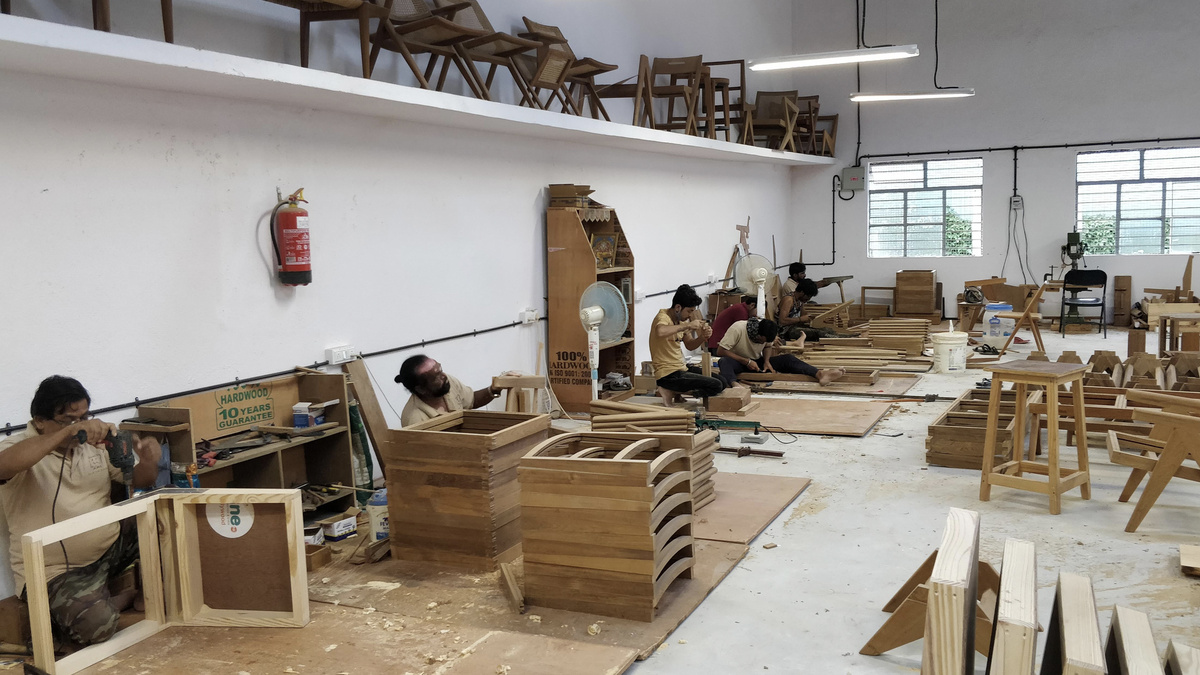
The carpentry unit at Phantom Hands. Our carpenters prefer to sit on the floor, in the traditional way, and use not just their hands, but also their feet to provide support to the piece they are working on. All images courtesy: Phantom Hands.
Parni Ray
29.10.2021
Phantom Hands’ 30-member strong carpentry team consists largely of carpenters from traditional woodworking communities. A good number of them have been working with wood since childhood.
Working at Phantom Hands has, however, pushed all of them beyond their comfort zones. Besides compelling them to work with solid, high quality wood (a far cry from the material most of them are used to), it has also made them abide by stringent quality standards and collaborate with designers they often don’t share a language with.
Taking each of these challenges head on, the carpentry team has re-edited a range of famous mid-century furniture pieces and crafted several contemporary collections.
A chat with the carpenters of Phantom Hands about carpentry, community, learning by making, and the future of wood crafting.
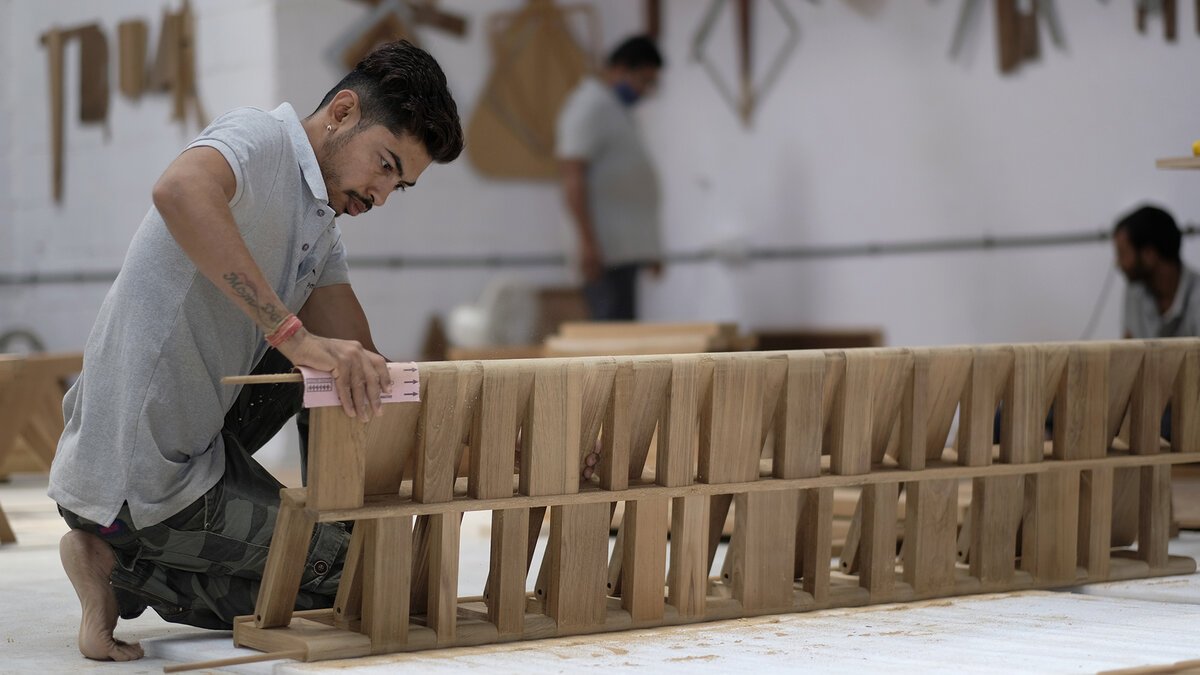
Itinerant Occupation
He was 19 when he left home, Sravan Kumar shares as he settles into his chair. It has been a decade since.
We are in the packing department at the Phantom Hands workshop. The neatly labeled cardboard boxes around us contain approved versions of the same chairs we are sitting on. Our chairs are "rejects," Sravan explains.
The carpenter hails from the city of Jodhpur in Rajasthan, approximately 2,000 km away from Bangalore, where he now lives and works. Being away from home was no longer difficult. Moving from one place to another is not an 'occupational hazard,’ but one of the attributes of his occupation.
Like most young men of the Suthar community, Sravan started working with wood at an early age...12 or 13, he cannot recall exactly. In a few years, he was deemed old enough to start earning, so his father fixed him up with a contractor he knew in Gujarat. Sravan packed up and left. Since then, he has worked as a carpenter across West India – a year in Surat, six months in Goa, another few in a small town in Karnataka. All before landing at Phantom Hands in 2016.

Divine Draftsman of the Universe
Others from his hometown joined him at Phantom Hands soon after. This was typical, sort of an unspoken pact. "My people travel in search of work. When one of us lands a good stint somewhere, we call our cousins and relatives to form a team. We work, live and eat together as long as the project lasts. Then we go our own ways, and when we find a job again, we try to involve each other," he shares.
This keeps food on the plate for the whole community, but it's also a canny professional move, he insists, because no one crafts wood the way that the Suthars do.
The Suthars (or Sutradhars) are a craft community traditionally associated with carpentry. Alongside the Lohars (blacksmiths), Mistris (builders) and other technical crafts groups, they are believed to be the descendants of the Hindu deity 'Vishwakarma' - the divine draftsman of the universe.
Though scattered across the country, the Suthars are largely concentrated in the states of Rajasthan and Gujarat. Their making skills are transferred generationally, and famously exemplified by the fantastic doors and windows of the forts in Rajasthan.
Despite their longstanding status as craftspeople, however, the Suthars remain a socially and educationally disadvantaged group. The Indian government classifies them as an OBC or Other Backward Class (caste) in acknowledgment.
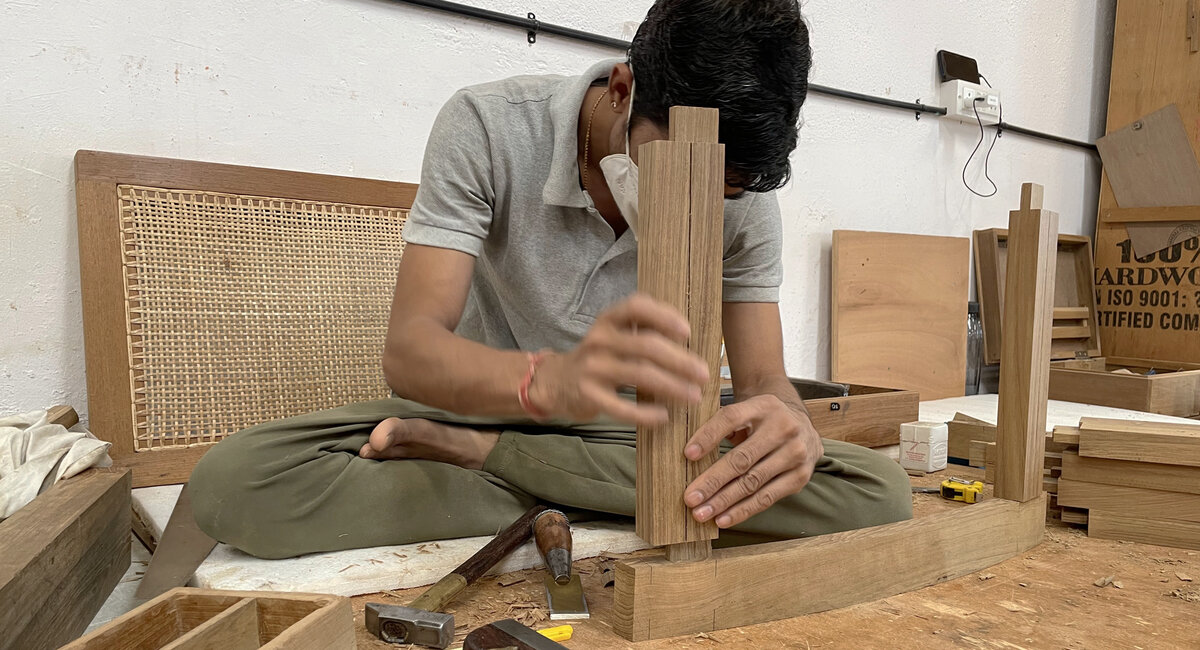
Learning by Making
Our words keep getting drowned by the rumble of the large truck that has pulled up next to us. The packing staff apologise as they load the large square boxes onto it. Like Sravan, they are in their grey Phantom Hands t-shirts.
Yes, things were very different when he first got here, Sravan says, raising his voice over the din. He was among the first carpenters recruited. The workshop was far from its current form. He gestures to the corner where he - and the two team members he brought with him - worked on the first chairs.
"As the only carpenters at the time, we figured out a lot about how we could make the chairs on our own," he recalls. It wasn’t easy. Almost everything at Phantom Hands was unlike anywhere they had worked before. The most crucial difference was a fundamental one – wood.
"In most parts of India, carpenters like us work with plywood. Sometimes, we get to make a wooden table, a door or a window here and there, but rarely do we get to work with solid teak of the quality we have here," he confesses. Wood takes time to get a hang of, he explains as we head out of the packing area and into the well-lit narrow alcove where the timber is laid out for seasoning.
I admired the grains of the long pieces of planks as Sravan explains how long it would be before these would be put to use. He and the other carpenters didn’t go to acquire wood from the mills, as there are others who look after that. That process needs people who spoke the local language and he is still learning, he says with a smile.
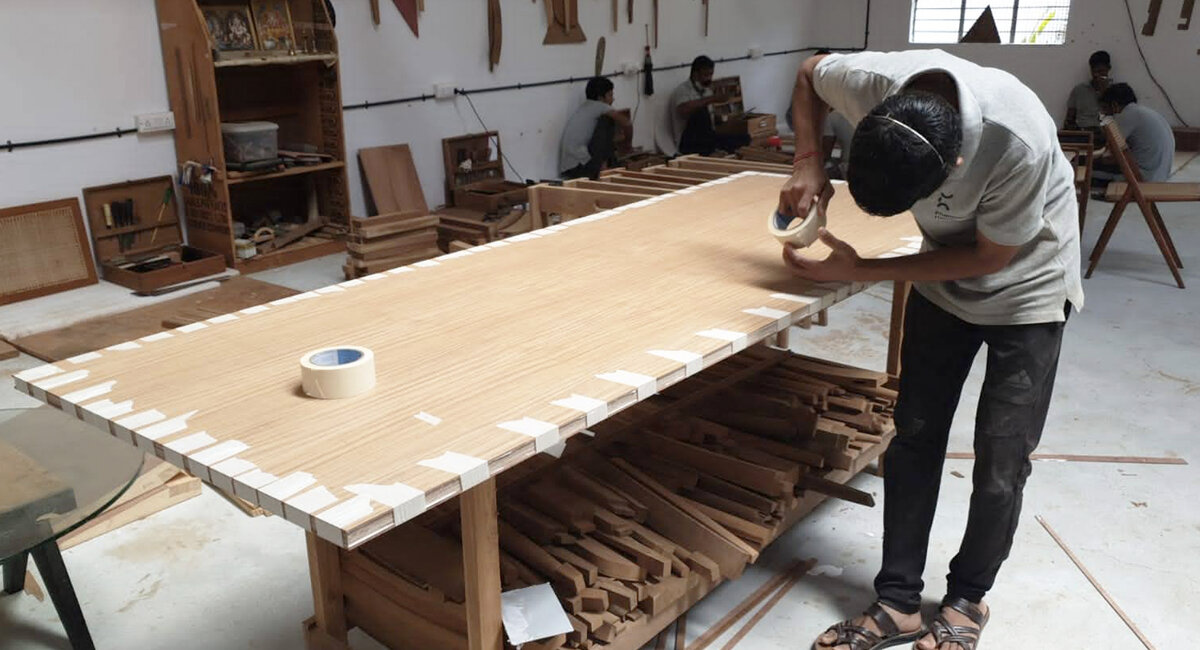
A Language of Gestures & Drawings
The workshop is a fertile place for sharpening language skills. The staff speak a variety – Kannada, Malayalam, Tamil, English, and Hindi. Even the five furniture designers that Phantom Hands is currently collaborating with are multilingual. But not all of them share a language with Sravan and his team. It had been an issue at the very beginning, he confesses.
Much like most of his team members and Phantom Hands' first designers, Sravan speaks little English, so verbal exchanges with them were "not always smooth". But gestures often speak more than words, he points out, and it didn't take them long to devise a physical vocabulary of their own.
"Besides, they work with drawings, which has a tongue of its own," Sravan says.
Old Hands, New Tricks
Sravan had been introduced to technical drawings during his early days while working under a contractor in Gujarat. But not everyone in his team - or community - feels at home with it. Drafting is not common among Suthars, who have a low literacy rate, Sravan suggests.
Using technical drawings is also often indicative of a form of organised training that craftsmen like him, who are trained via familial apprenticeships, do not typically receive, he explains.
As a community proud of its generational knowledge, opting for institutional training is not common among Sravan’s people, but several well-known organisations have been known to train woodworkers in India. These include the Indian Technical Institute, the National Institute of Open Schooling, training centers under the Ministry of Environment, Forestry and Climate Change, and the National Skills Development Corporation of India. A few new private institutions focused on vocational skills, such as the Bharatiya Skill Development University in Jaipur, have also started providing similar training.
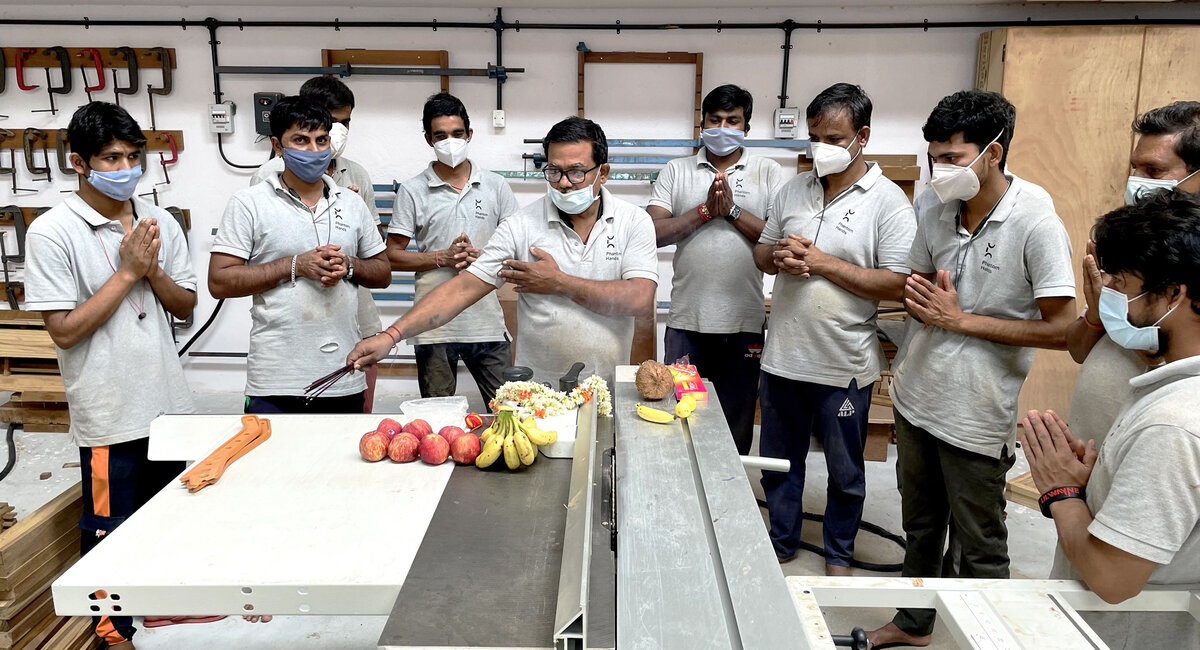
Value of Precision
Among the 20-member carpentry team at Phantom Hands, only one, Achintya Sutradhar, has a diploma in furniture-making. We are introduced in the evening over tea. He is from the Birbhum district of West Bengal, and as a new recruit, still hesitant in the workshop setting. We thus spend a while vacillating over where we could sit for a chat and the language we should use (we settle on Bengali).
It has been over two decades since he finished his course at Viswa Bharati University, Santiniketan. Since then, he has worked as a craftsman in Sriniketan and then as a draughtsman and site supervisor for various companies in Bangalore. He joined Phantom Hands as a carpenter less than six months ago, after being rendered without a job by Covid for several months.
"I specialised in joinery, anthropometry, furniture anatomy drafting," he explains. But it had been years since he had built things with his own hands. This meant he had to re-learn much. It also meant that he made mistakes, repeatedly, recalls Achintya.
Mistakes are not unknown at the Phantom Hands workshop, others make them too. But his errors occurred mainly because he wasn’t accustomed to the stringent standards by which work is judged here, he says. "A few centimeters here and there was never considered a problem in any of the places I have worked at before. But here, items get rejected if they differ from the template even by a couple of millimeters. It is completely unlike what I have seen through my decade and a half long career."

Wood is a Tough Taskmaster
Quality checks occur at every stage of making at the Phantom Hands workshop. "It starts with a moisture check for the wood. Later, once the work is divided amongst the team and the joints are made, there is a check. Then the holing for the caning is checked for uniformity and distance…," trails of Achintya.
Each part of every furniture built at the workshop is made using templates. "Still, mistakes can happen at any stage. A few millimetres off and the piece has to be reworked, or rejected," he continues.
Often an otherwise perfect, fully-finished piece, will show a crack right before being packed. "Imagine that, all that work, wasted. But there is only that much control you can exert on wood and almost none on the appearance of cracks," he describes in horror.
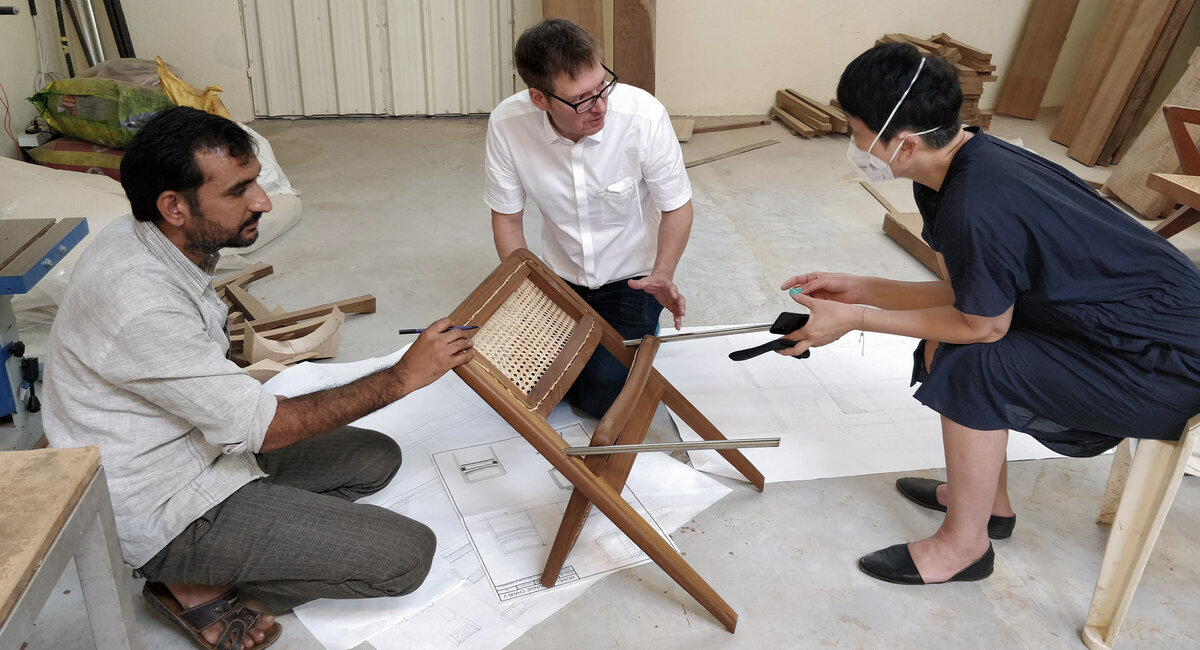
A Good Carpenter Never Blames his Tools
Some pieces are harder than others, Sravan says (‘like everything in the Mungaru Collection’), and yes, mistakes happen. But he is no longer afraid of them. "Being a carpenter is not easy," he says after a brief pause, "there are so many other fears to contend with."
I am not sure what he means, so I take a shot in the dark, "injuries and respiratory trouble?"
He shakes his head and laughs. "I mean there is no hope for a stable future as a carpenter, there is little room for growth, earnings are low and jobs sporadic. Everything you earn, you end up spending while you wait for a new job. Take my uncle and dad for instance, both in their 60s, have worked for more than four decades and still can’t retire because they have nothing." Sravan is now among the handful in his 200 member extended family who have a permanent salaried job, he says.
It is because of this instability within the profession that the younger members of the Suthar community today aspire to become architects and engineers. "They don’t see carpentry as a dignified profession, as there is no financial stability and esteem attached to it," says Sravan.
This is perhaps why even institutionally trained carpenters like Achintya prefer moving to ancillary roles. He doesn’t know if the making tradition of the Suthars will last. "But I know that carpentry will," he affirms with hope.
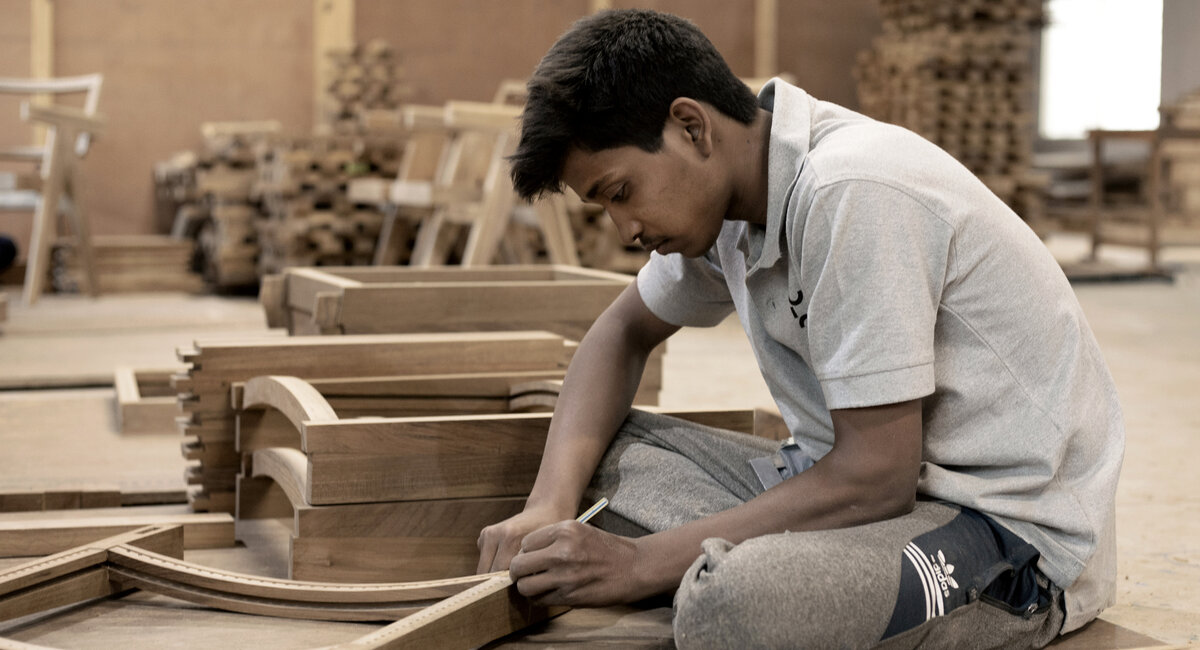
Integrity in Woodworking
Day after proves busy. Sravan is in a hurry to get his work done because he is leaving for home next week. (‘It’s Holi!’ he announces with a grin.)
He is in the middle of finishing up a chair and chats while he puts in the finishing touches. I want to know more about the future he imagines for his community. Did Sravan have kids? Would he want them to join his trade? "Yes," he says without hesitation. "I think there is integrity and honesty in making and I will always tell my kid so."
He wants to introduce his daughter to woodworking in a few years, when she comes of age. He brushes away the dust from the arms of the chair he is working on. Soon, it would join a lineup heading to the packing section and then be shipped to a home far away.
Once done, Sravan shows me around the workshop like a house-proud parent. He points to the templates hung on the wall, the neat workstations on the floor, and the machines. "The hand, it gets tired, but the machines don’t," he says, demonstrating how it works.
A majority of the work that happens in the workshop is by hand. But the few machines that were introduced to the process over time are helpful, he admits. They aid the making process, and make banal activities like cutting and leveling quicker and easier. It can be a monotonous job, Sravan tells me, making the same things over and over again. Time is not your friend when much of your work is repeating your actions.
What does he prefer working with, hands or machines? But the question confuses him. "The machines also need the hand," he says.
Sravan bids me a quick goodbye and makes his way back to his workstation. It is a tidy little space, surrounded by the stations of his team members. They crack a joke and share a laugh as he gets back to the grind.
The sound of their hammers and chisels carries through the walls.
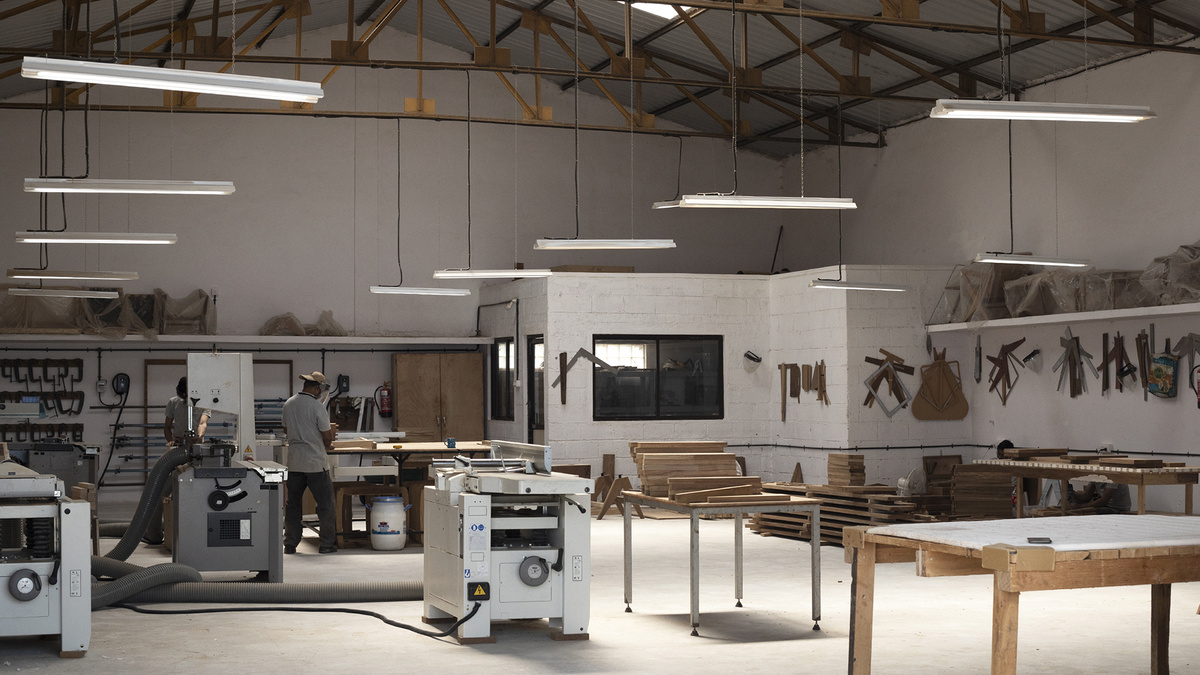
Handcrafted Modernism: A Short Video on Craft & Design at Phantom Hands
With footage and interviews filmed between 2019 and 2021, this short film offers a glimpse into the process of co-creation between designer and artisan at Phantom Hands.
Read More